The prettiest hilltop ’hoods in Italy
To see some of Italy’s most beautiful locations, replete with cobbled courtyards, grand palazzi and crumbling ruins, head for the hills.
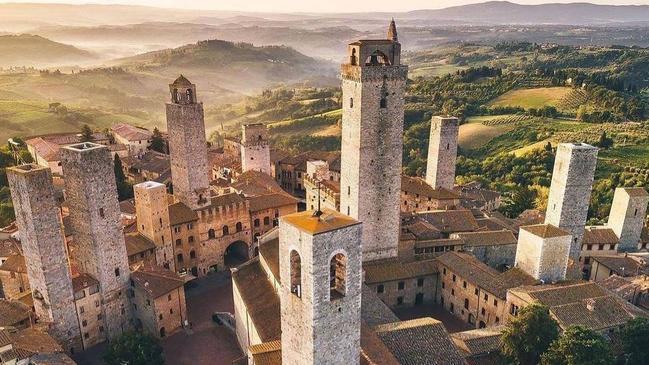
Impossible is the response I get over and over again when I ask the Italians I know to choose the best hilltop towns in the country. It’s not that they won’t, they simply can’t. A nation with more than 70 mountain ranges, plus countless smaller peaks and troughs, has a lot of high points. Picking the finest examples is tough.
In this selection we’ve ignored the seven hills of Rome – they’re a story unto themselves – and tried to balance the big-hitters (Matera, Taormina, San Gimignano) with those you might not know: Santa Severina? Pietrapertosa? Brisighella? What they all have in common, though, is a degree of altitude and an even greater degree of charm.
Many date from the Middle Ages and were founded on sites first populated by the Etruscans, who lived from 900BC in what we now call Tuscany and Umbria until they were “incorporated” into the Roman Empire. These towns and villages are often fortified and topped by castles, with defensive walls and towers, narrow streets and cobbled courtyards, grand palazzi and crumbling ruins, all of which add to that fairytale feel.

MATERA, BASILICATA
One of southern Italy’s strangest sights, Matera is as otherworldly as any film set. And that’s where you might have seen it: in No Time to Die, Bond’s Aston DB5 races through the narrow streets. This community of sassi (caves hollowed out of the soft rock to form a maze of windowless houses, frescoed churches and tiny shops) was cleared in the 1950s, its residents rehoused. Now creatives are breathing new life into the caves, starting up cool hotels – Sextantio Le Grotte della Civita is the best – as well as artists’ workshops and Michelin-starred restaurants (try Vitantonio Lombardo); B&B doubles from $360.
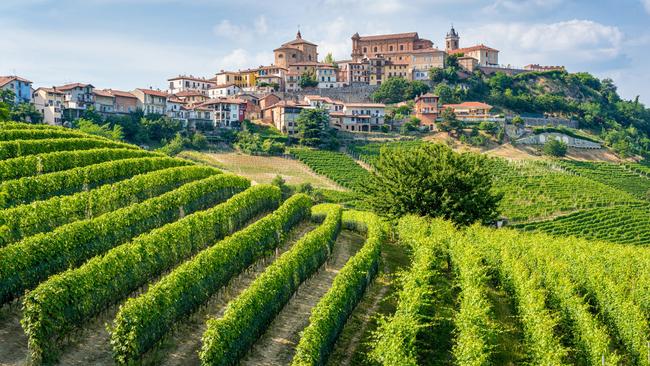
LA MORRA, PIEDMONT
The loveliest of the 11 hilltop towns that make up the Barolo region, medieval La Morra is the prime producer of the “king of wines”. Local growers Giovanni Corino, Marcarini and Cascina Ballarin welcome visitors for tastings. Walk the 5km Sentiero dei Grandi Orizzonti (the footpath of wide horizons) for the best views of the Langhe; high points include the church of San Martino, the weathered exterior of which gives little clue to the majesty within. For dinner, book the tasting menu at Ristorante Bovio and stay at Fior di Farine, home to four generations of millers; from $145.
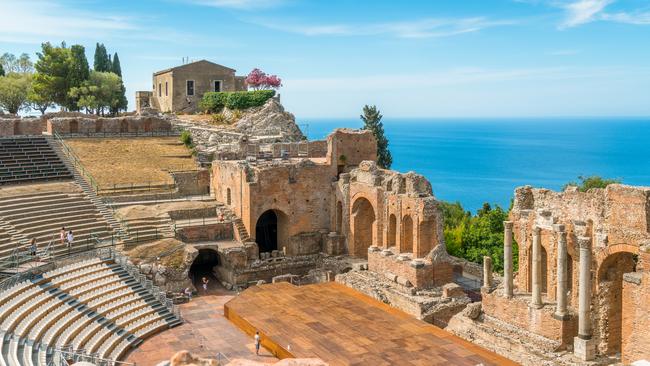
TAORMINA, SICILY
From its perch on a headland overlooking the Ionian Sea, Taormina commands some of Sicily’s most startling views, but it means that in high season Corso Umberto I, the dreamy, bougainvillea-lined main street, is crammed with visitors. Escape to the Teatro Antico, the amphitheatre dating from the 3rd century BC and Greek colonial times, where you can still catch a modern gig along with views of Mt Etna. On Via di Giovanni, grab a glass of Sicily’s best lemon granita at BamBar before checking into the super-luxe Belmond Grand Hotel Timeo; from $596.
PIENZA, TUSCANY
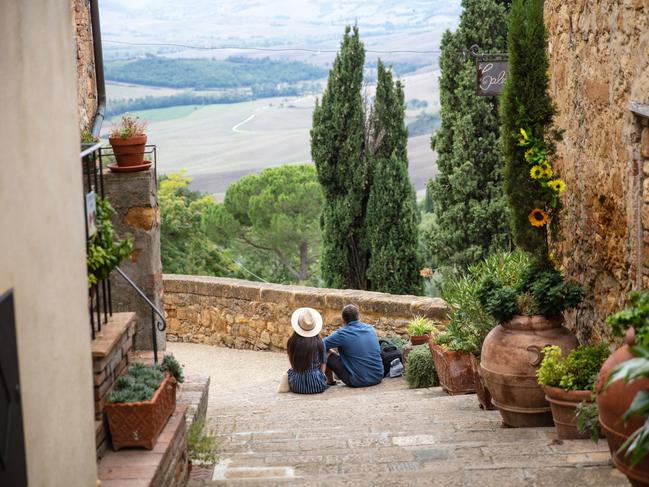
When it comes to delicious hilltop towns in Tuscany you are spoilt for choice. This particular Renaissance contender was designed in the mid-1400s by Pope Pius II as a means of reinventing his home town (previously called Corsignano) as a model for architectural beauty. The results are impressive, with a central piazza lined on three sides by handsome palazzi; on the fourth is the elegant Duomo. Stop for an aperitivo at Bar Il Casello, which has jaw-dropping views of the Val d’Orcia, a UNESCO World Heritage site with a dormant volcano as its backdrop. Stay at the cool 12-room La Bandita Townhouse; from $415.
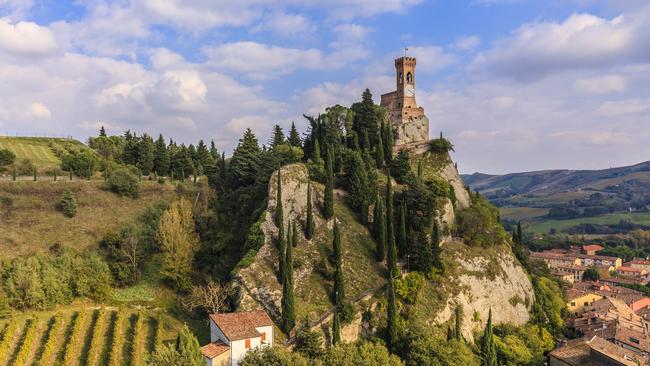
BRISIGHELLA, EMILIA-ROMAGNA
Fairytale Brisighella is flanked by three green hills. On the first there’s the dramatic 14th-century castle of La Rocca; on the second a 19th-century clock tower; and on the third the frescoed sanctuary of the Madonna del Monticino. All bear exploring before you descend into this foodies’ paradise where specialities include forgotten fruits such as the volpina pear; the best sangiovese di romagna wine; conciato cheese, ripened in chalky caves; and pork from the local mora romagnola breed. Book a room at the family-run La Rocca with its excellent restaurant; from $90.
SAN DANIELE, FRIULI VENEZIA GIULIA
In the battle of Parma v San Daniele hams, producers from the tiny Friulian town generally come out on top. Visit Prosciuttificio Bagatto to learn how this three-generation family business put ham on the gastronomic map. In Sant’Antonio Abate, Pellegrino da San Daniele’s intense frescoes have earned it the reputation of the “Sistine Chapel of Friuli”. Also visit the Biblioteca Guarneriana, a library that opened in 1466 and has priceless first editions, including Dante’s Inferno. The funky Hotel San Daniele is great value for the middle of town; from $126.
OSTUNI, PUGLIA
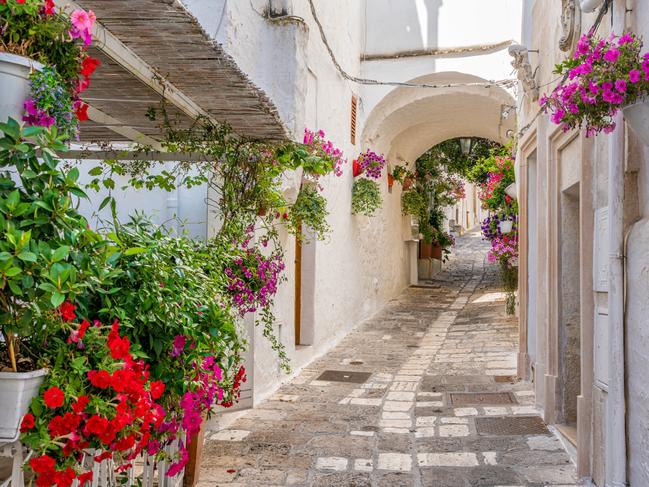
This white city could easily be mistaken for one on an Ionian island. That’s because when La Citta Bianca was destroyed by Hannibal during the Second Punic War, it was the Greeks who rebuilt it, turning it into a Pugliese bastion. Today its cobbled lanes, lined with low whitewashed buildings, wind up the hill to the gothic cathedral of Santa Maria Assunta. Ostuni’s olive groves stretch down to the Adriatic. Make time to visit Masseria Brancati, an ancient mill, where you can taste oil from 2000-year-old trees. Stay at La Sommita, a minimalist 16th-century palazzo with exceptional views; from $315.
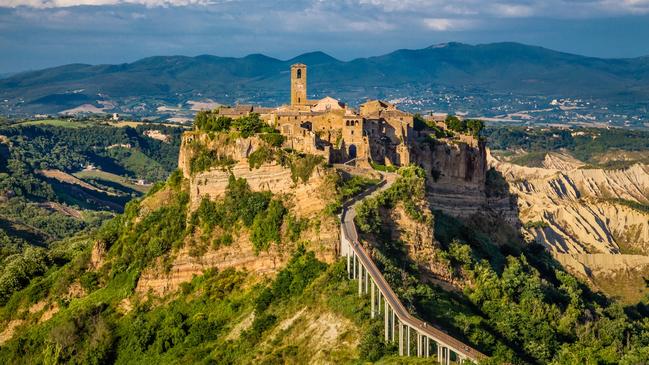
CIVITA DI BAGNOREGIO, LAZIO
It’s known as la citta che muore – the dying city – but there’s nothing macabre about Civita di Bagnoregio. It’s simply wearing away, its base of volcanic tuff eroding and its residents (the winter population is 12) departing. Reached by a footbridge hammered into the cliffs, this Etruscan settlement founded 2500 years ago on a plateau above the Tiber Valley is a place of startling isolation, its architecture a mix of medieval and Renaissance. The Church of San Donato is a sleepy delight. Book one of the four suites at Corte della Maesta, where they have perfected the art of dolce far niente (what we call carefree idleness); from $548.
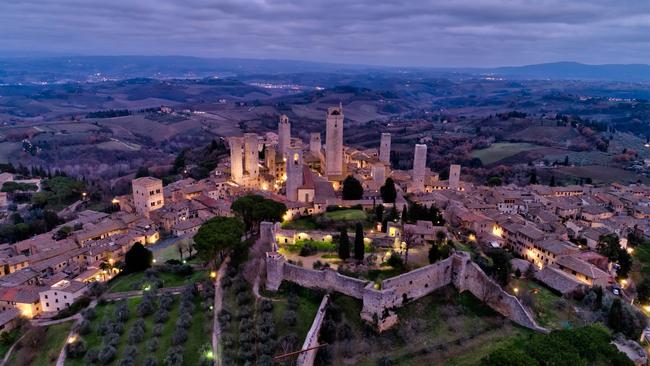
SAN GIMIGNANO, TUSCANY
Today only 14 towers remain in this medieval Manhattan, a World Heritage site where once there were 72, some as tall as 70m. Built as lookouts by San Gimignano’s warring families, they were all but deserted when the Black Death ripped through the region in 1348. Now they loom like something out of a fairytale in this perfectly preserved pitstop on the Via Francigena, the pilgrims’ route from Canterbury to Rome. Visit the Santa Fina Chapel in Santa Maria Assunta for its divine frescoes. Book early for Casanova di Pescille, an excellent agriturismo outside the city walls; from $195.

SANTO STEFANO DI SESSANIO, ABRUZZO
More than 1km up, in the shadow of the Gran Sasso massif in the Apennines, Santo Stefano is a village with its heart in the Middle Ages. By the early 2000s the population of this former wool-trading post had dwindled to just 100. Then the Milanese maverick entrepreneur Daniele Kihlgren bought a house. By 2004 he had opened Sextantio, his first albergo diffuso, a scattered hotel in the restored village. Now Sextantio offers classes in traditional crafts: make bread and milk biscuits in a 16th-century oven; cook an Abruzzese dinner using “zero-kilometre” local ingredients; or weave a scarf on an ancient loom; from $205.
RAGUSA IBLA, SICILY
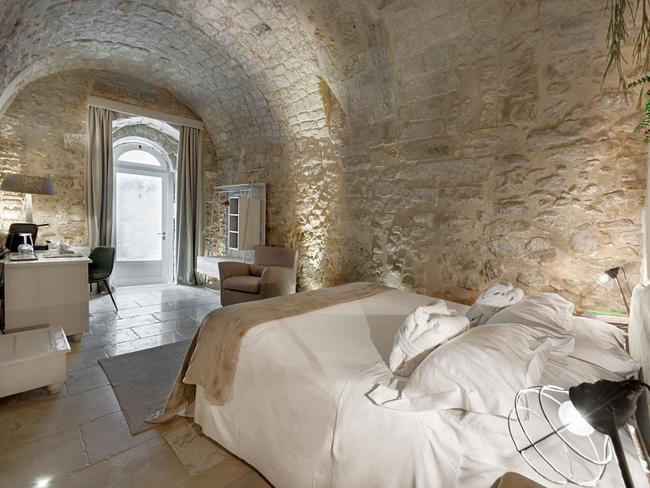
Fans of TV series Inspector Montalbano will recognise Ibla from the startling opening shots of the long-running detective show. The old city is a baroque masterpiece – separated from the “modern” Ragusa Superiore by a chasm wrought by the earthquake of 1693 – with Rosario Gagliardi’s wedding cake Basilica of San Giorgio a highlight. Follow in Montalbano’s footsteps with an aperitivo at Caffetteria Donnafugata, before dinner at Ciccio Sultano’s two-Michelin-starred Duomo, which some would say is the best restaurant in Sicily; the chef’s lasagne with blue lobster, shrimp and calamari is unforgettable. Stay at the 11-room Locanda Don Serafino, in a baroque palazzo hewn out of the rock; from $175.
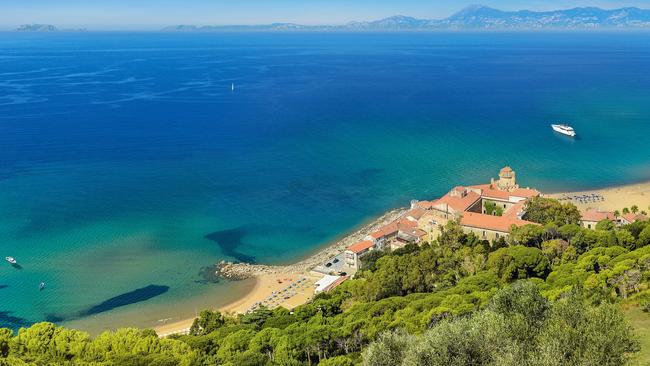
CATELLABATE, CAMPANIA
Neapolitans in the know swerve the Amalfi Coast in summer; instead, they head south to Cilento, Vallo di Diano and Alburni National Park and the two-bit town of Castellabate. Standing at an altitude of 290m, the old half is a glorious cluster of winding lanes, tiny bougainvillea-lined piazzas and a crumbling 12th-century cliff-edge castle, built by Abbot Costabile Gentilcore as protection from the Saracen hordes. The bells of the basilica play Ave Maria at noon. Views tumble down to coastal Santa Maria di Castellabate, a jumble of fishermen’s cottages, noble villas and waterside bars where you can stay at the Palazzo Belmonte, which has its own beach; from $300.

SANTA SEVERINA, CALABRIA
Historically one of the poorest regions in Italy, Calabria is blessed with spectacular mountain villages. Santa Severina is one of the best, with its Byzantine baptistry, 11th-century Norman fortress and the matchbox Church of Santa Filomena, where for €1 ($1.50) the gnarled guardian will tell you the story of the Madonna of the Well, who many centuries ago saved a child from drowning and is still worshipped today. At La Locanda del Re, below the castle, you’ll get excellent food with even more delicious views thrown in. Stay at the two-room B&B Mesovia in the village centre; from $80.
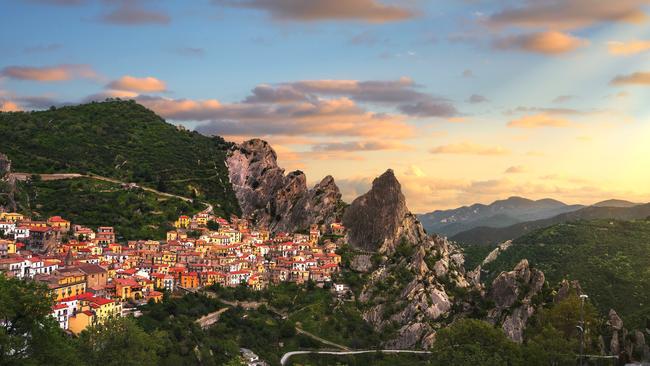
PIETRAPERTOSA, BASILICATA
Built into the clefts of a giant rock, Pietrapertosa doesn’t just look dramatic, it’s also a hotspot for extreme sports. The Volo dell’Angelo claims to be the world’s highest zip line; you’ll whizz from the peak of nearby Castelmezzano into the village, an adrenaline-filled glide over sharp spikes and around hairpin bends, more than 1000m up in the Lucanian Dolomites. And that’s not the only thrill: Pietrapertosa has a wealth of photogenic ruins, soaring views and a 9th-century Saracen castle. Dine at Agriturismo Taddeo, where produce is home-grown, and stay at Il Palazzo del Barone, close to the zip line; from $90.
THE TIMES

To join the conversation, please log in. Don't have an account? Register
Join the conversation, you are commenting as Logout